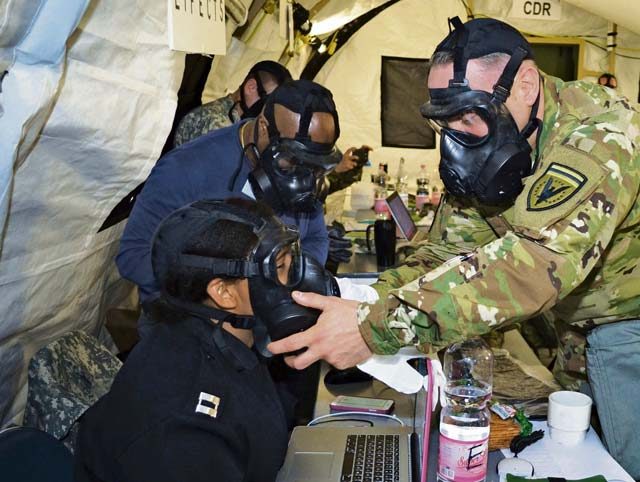
PAPA AIR BASE, Hungary — Three countries practiced working together during Exercise Anakonda Response 2016, a joint-service, multinational exercise that included military and government civilians from Hungary, the United Kingdom and the United States.
The goal of the exercise was twofold: test and evaluate the 7th Mission Support Command’s military effectiveness in a multinational humanitarian relief effort and build real-world bonds with fellow NATO-country militaries.
“Our goal coming into this was to train the staff and have them gain an understanding of foreign humanitarian assistance and disaster response; and I think we went a long way to accomplishing that,” said Lt. Col. Lance Oliver, 7th MSC chief of plans. “Another mission goal was building relationships. And I think that was the biggest take away from this, not only with our host nation, but with all the participants in the exercise.”
For the roughly two-week-long event, the U.S. organized a full assembly of military representation: Army, Navy, Marine Corps, Army Reserve, Army National Guard and Air National Guard. Also, the Hungarian military hosted the United Kingdom’s Royal Army and Corps of Royal Marines.
The array of military constituents worked with previously unfamiliar comrades toward achieving a common goal. By doing so, bonds were built. Upon the exercise’s end, leaders from all three countries viewed the scenario as an overwhelming success.
“I think the exercise has reached its aim, because the aim was to see and to work out how we can work together efficiently, and this has never happened before between the (Hungarian and U.S.) forces,” said Col. Csaba Szarka, the Hungarian officer in charge. “And it was not only to incorporate the military forces, but also with the civilian parts as well. And our forces received the necessary training to be better prepared for the next scenario, hopefully. ”
Hungary not only served as the host, but was also the nation upon which the scenarios were based.
In 2010, the retaining wall of a caustic waste reservoir in the country collapsed. Releasing more than 38 million cubic feet of highly-alkaline red sludge, the toxic material flooded several villages, killed 10 people and injured more than 120 with chemical burns.
Exercise planners used these factual events to fashion some notional incidences, while also incorporating fictional content to maintain training currency.
Created to be challenging, participants were clearly tested by the experience. Many stated that the scenarios, and real-world trials, served to assemble a more skillful total-force military.
“It’s the connectivity; the common thread. It’s the people who make this work,” said Color Sergeant John Dixon of the No. 3. Column, 77th Brigade, Dennison Barracks, Royal Marines, United Kingdom. “The people coming together with a common goal, a common understanding to take this forward; and with that, strengths are built. This experience is going to prove mutually beneficial across the whole of the sphere.
“When I see what’s going on during this exercise, it tells me that people are talking to each other. When that happens, so can progress toward a mutually beneficial goal.”
With the success of this year’s exercise, the planning for next year has already begun.
“I hope that we can continue to develop the relationships that we had to establish to do this,” said Oliver. “And that’s where we’re at. We’re looking forward to maintaining the relationships. So we get the participation again next year and continuing to work with our Hungarian allies, we have to maintain momentum.”


